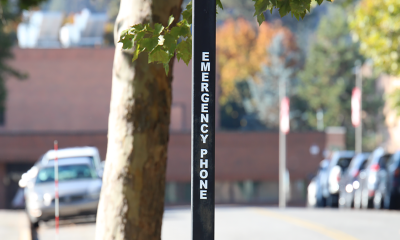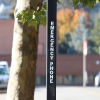Artist Rick Davis' Hindue statue of Ganesh has created quite a stir among spectators on Sherman Avenue.
This summer’s controversy over the statue of the Hindu god Ganesh on Sherman Avenue, prompted the Human Rights Education Institute (HREI) to cohost “Constitution Day: Understanding the First Amendment” with North Idaho College on Sept. 14.
“We thought it was a good trigger for what the First Amendment and art is all about,” said Marilyn Muehlbach, president of the HREI board of directors and the program’s moderator.
The discussion panel included Rick Davis, the statue’s creator; Eden Irgens, a member of the Coeur d’Alene City Arts Commission; George Critchlow, a professor at Gonzaga University Law School; and Sreedharani Nandagopal, a math instructor at Spokane Falls Community College and a member of the Hindu faith.
A local group has raised opposition to the statue, objecting to its connections with Hinduism. The group labeled it an “idol” and a “demon” and claimed its trunk is a phallic symbol.
“I guess people walking on Sherman might say it’s an obstruction, but it’s not even on the sidewalk,” Davis said.
Ganesha is called the “remover of all obstacles” in the Hindu tradition. Nandagopal said the purpose of a statue is to have something to concentrate on. Ganesha’s full name means the “Master of all the People.” Nandagopal said that Hindus worship the supreme being in all forms.
“[But] the first thing we do is worship Ganesha,” Nandagopal said.
Critchlow approached the subject from the perspective of the First Amendment.
He referenced previous Supreme Court cases, including the “Lemon Test,” which is a method of determining how far the government goes into religious matters.
According to the U.S. Constitution Online, the Lemon Test’s three parts are, “First, the statute must have a secular legislative purpose; second, its principal or primary effect must be one that neither advances nor inhibits religion; finally, the statute must not foster an excessive government entanglement with religion.”
Critchlow said the Supreme Court’s precedent is to allow religious symbols like crèches and the Ten Commandments when they are outside of government buildings, surrounded by other religious references, or they are old enough that it is no longer promotional.
“In the U.S., we don’t have an official religion, and never have,” Critchlow said.
Davis also made the St. Francis of Assisi statue on Sherman Avenue and the heron statue on Lakeside Avenue.
There have been no complaints about the St. Francis statue, except “from my sons, who help me move the pieces,” Davis said.
He made all of them from scrap metal, which he said is his favored medium.
“I’m a natural-born scavenger,” Davis said. “Scrap metal is… the way I work.”
The statues are part of the ArtCurrents program, which Irgens said operates on the premise of “art on loan.” The art is displayed downtown for a year, and when it is sold, the city takes a 1.33 percent commission and the artist takes the rest.
“I appreciate my art shown for a year,” Davis said. “I never had any ideas of creating a controversy.”
The submitted art was required to be over 36 inches tall, durable enough to be outside, and perhaps withstand graffiti.
Citizens of the community approved the art, including people living in the neighborhoods where the art is on show. No members of the Coeur d’Alene Art Commission took part in the decision-making.
“We believe in the power of public art,” Irgens said.
Nandagopal said that the Ganesha is art, unless she puts it in her place of worship.
“Art is by its very nature the medium in which we talk about the transcendent,” Critchlow said. “It represents the whole range of human experience.”











